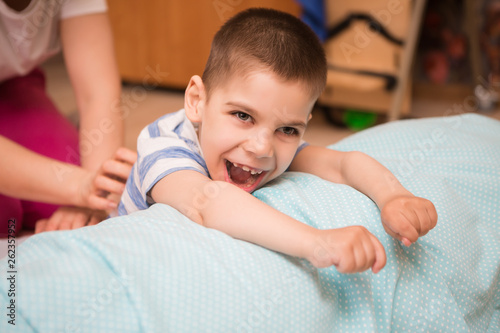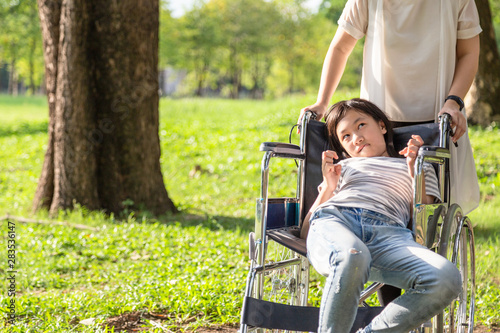Cerebral Palsy
What do you mean by Cerebral Palsy (CP) ?
Its a disorder of signals of brain to different parts of the body due to injury to developing brain in
early part of the life. This leads to weakness , stiffening of muscles and joints. As a result the child
has several disabilities such as difficulty walking , poor hand functions , vision and hearing
impairments.
How common is Cerebral Palsy ?
It's 2-2.5 per 1000 live births .
What are the causes of this ?
50 Percent of the cases are unknown.Premature delivery is the commonest risk factor. Difficult and prolonged labour , neonatal jaundice , pneumonia , meningitis etc. can also pose risk for CP after birth.

What are clinical presentations of CP ?
There will be delayed developmental milestones.
Normal pattern of smiling in 3 months , sitting after 6 months , crawling after 9 months , walking in 12-18 months will not be seen in babies affected with this condition.
With development parents may notice rigidity or weakness of the extremities .They may also require support to position their body parts for the posture
Vision and Hearing Impairment
Drooling , feeding difficulties , unnourished
Epilepsy
Mental Retardation
Sleep Disturbances - unable to maintain sleep , nocturnal awakeness
Bowel and Bladder dysfunction
Its important to understand that such children may not have all symptoms. Only mild symptoms may
be present in some such as just asymmetry of body and face.
How can we classify this problem ?
Different classifications are in vogue.
a.Pathophysologic
1.cortical(Pyramidal) - Spasticity is the hallmark.
2.Extrapyramidal - Basal Ganglia is affected.There will be movement disorder.
3.Cerebellar- Hypotonia is the hallmark.
4. Mixed - More than one feature.
b. Etilogical
Congenital - developmental,malformations or syndromic
Acquired - traumatic, infectious,hypoxic,ischaemic , TORCH infections
other way
Prenatal /natal or postnatal.
How to diagnose CP ?
Comprehensive review of history and neuological examination is required. Perinatal history is
important. Unexlplained early deaths in family or neurodegenerative diseases in family indicates
inherited neurodegenerative diseases.
Other diseases that should be differentiated from CP are Glutaric aciduria type 1 and dopa respnosive
hyptonia (Segawa disease )
What's the treatment goal ?
The goal of treatment in this group of patients is to improve (sequentially )
Speech and Hearing for communication
Activity of Daily Living
Ambulation
This way they can me made independent to some extent.
What's the treatment ?
Early age - Physiotherapy to prevent joint contractures , Braces in night time to support joint.
Medicine - oral - Diazepams , Baclofen
injections - Botox - to diminish muscle tone
baclofen pump
Surgery - To correct deformity - Tendon lengthening
surgery for scoliosis ,
joint relocation - open or closed
flat foot - arch resontruction surrgery
Dorsal Rhizotomy
One can email and send me queries
suryathapa145@gmail.com
Its a disorder of signals of brain to different parts of the body due to injury to developing brain in
early part of the life. This leads to weakness , stiffening of muscles and joints. As a result the child
has several disabilities such as difficulty walking , poor hand functions , vision and hearing
impairments.
How common is Cerebral Palsy ?
It's 2-2.5 per 1000 live births .
What are the causes of this ?
50 Percent of the cases are unknown.Premature delivery is the commonest risk factor. Difficult and prolonged labour , neonatal jaundice , pneumonia , meningitis etc. can also pose risk for CP after birth.

What are clinical presentations of CP ?
There will be delayed developmental milestones.
Normal pattern of smiling in 3 months , sitting after 6 months , crawling after 9 months , walking in 12-18 months will not be seen in babies affected with this condition.
With development parents may notice rigidity or weakness of the extremities .They may also require support to position their body parts for the posture
Vision and Hearing Impairment
Drooling , feeding difficulties , unnourished
Epilepsy
Mental Retardation
Sleep Disturbances - unable to maintain sleep , nocturnal awakeness
Bowel and Bladder dysfunction
Its important to understand that such children may not have all symptoms. Only mild symptoms may
be present in some such as just asymmetry of body and face.
How can we classify this problem ?
Different classifications are in vogue.
a.Pathophysologic
1.cortical(Pyramidal) - Spasticity is the hallmark.
2.Extrapyramidal - Basal Ganglia is affected.There will be movement disorder.
3.Cerebellar- Hypotonia is the hallmark.
4. Mixed - More than one feature.
b. Etilogical
Congenital - developmental,malformations or syndromic
Acquired - traumatic, infectious,hypoxic,ischaemic , TORCH infections
other way
Prenatal /natal or postnatal.
How to diagnose CP ?
Comprehensive review of history and neuological examination is required. Perinatal history is
important. Unexlplained early deaths in family or neurodegenerative diseases in family indicates
inherited neurodegenerative diseases.
Other diseases that should be differentiated from CP are Glutaric aciduria type 1 and dopa respnosive
hyptonia (Segawa disease )
What's the treatment goal ?
The goal of treatment in this group of patients is to improve (sequentially )
Speech and Hearing for communication
Activity of Daily Living
Ambulation
This way they can me made independent to some extent.
What's the treatment ?
Early age - Physiotherapy to prevent joint contractures , Braces in night time to support joint.
Medicine - oral - Diazepams , Baclofen
injections - Botox - to diminish muscle tone
baclofen pump
Surgery - To correct deformity - Tendon lengthening
surgery for scoliosis ,
joint relocation - open or closed
flat foot - arch resontruction surrgery
Dorsal Rhizotomy
One can email and send me queries
suryathapa145@gmail.com


Comments
Post a Comment